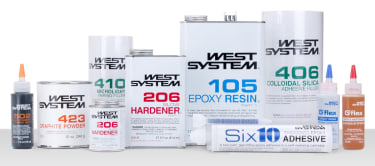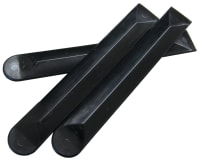Safely Working with Epoxy Resin

If you own a boat, it's highly likely that you'll need to work with epoxy and fiberglass cloth at some point or another as it is one of the most useful materials for repair and construction. However, before you use epoxy, it is critical to take some basic steps to protect yourself - exposure to unhardened epoxy can have serious short and long-term health consequences. Below, we outline some information on working with epoxy safely. At the bare minimum, you should always wear gloves, safety glasses and a respirator. Wearing protective sleeves, aprons, or coveralls is also a good idea.
Skin Protection
The first rule in working safely with epoxy is to keep it off your skin. Even minor contact can cause dermatitis (inflammation) or a more dangerous allergic reaction (sensitization). Once sensitized, further exposure to resin, hardener, their fumes, or even sanding dust from partially cured epoxy can bring on a reaction – and this lasts for the rest of your life! To make sure this does not happen to you, wear neoprene or quality nitrile gloves when working with epoxy. When cleaning up, you may need to switch to heavier solvent-proof gloves as neoprene and nitrile gloves may not withstand cleanup solvents such as acetone or, especially, lacquer thinner.

- Resin is not water soluble – so you will need to use a waterless skin cleanser to remove resin or mixed epoxy from your skin. Some people have also had luck using white vinegar if you are looking for a more “natural” cleaning solution.
- Hardener is water soluble – so you can wash with soap and warm water to remove hardener from your skin.
Even if you avoided getting anything on your skin, it's still important to wash off with soap and warm water after working with epoxy – showering is even better! Remove the clothes you've been using and if you have spilled epoxy on them, change immediately to avoid skin contact. Even partially cured epoxy on your work clothes can be a skin hazard with repeat exposure. Avoid wearing contaminated clothing from a previous work session by using inexpensive, disposable coveralls.
Remember that the more often you are exposed, the more likely you are to develop a problem. It's worth noting that you should never use solvents to remove resin or mixed epoxy from your skin as they can transport toxic components into your bloodstream. Always use a waterless skin cleaner instead.
 Inhalation Risks
Inhalation Risks
Epoxies typically have low emissions. However, the risk increases when ventilation is inadequate, exposure is prolonged, or when the products are heated. Mixed resin and hardener that become hot can generate toxic vapors. Cured epoxy can emit vapors when heated – as when using a flame to release epoxy-mounted hardware. Because of these factors, it's safest to always use a quality respirator when working with epoxy.
Extreme caution should also be used when sanding partially cured epoxy. Although epoxy is firm enough to sand within two hours, it may not cure completely for up to two weeks. Until then, sanding dust may contain unreacted hazardous components which can be inhaled or settle on your skin.
Do not overlook or underestimate this hazard. Always wear a cartridge-type or hooded powered respirator when sanding recently applied epoxy. Dust from fully cured epoxy, however, is inert and is only considered a nuisance dust.
 Mixing Safety
Mixing Safety
Mixed epoxy can generate an amazing amount of heat. The thicker the epoxy mass, the more heat it can generate. To prevent the mixed epoxy from getting too hot, transfer it from the mixing pot to a wide, shallow container. If you have unused epoxy after the job is done, make sure to monitor the batch – ensuring you have adequate ventilation and that you don't leave solvent filled rags nearby while you wait for it to cure for disposal.
Workshop Safety
Make sure you have good ventilation, especially when working in confined spaces – such as boat interiors. If ventilation is inadequate, wear a respirator with an organic vapor cartridge. It's best to clean up spills with a scraper, then absorbent towels. Use sand, clay, or cat litter to contain large spills. DO NOT use sawdust, as a fire hazard may result. Clean up resin or mixed epoxy residue with acetone, lacquer thinner, or denatured alcohol (but never on your skin). Clean hardener spill residue with warm soapy water.
Disposal of Leftover Resin and Hardener

When worked with properly, epoxy can fix or build a lot of things – so don't let these warnings scare you off. Just make sure that you follow the simple safety recommendations above and use good common sense. Use quality safety gear, work as cleanly as possible with adequate ventilation, and try your best not to get epoxy on your skin!
Fisheries Supply carries a huge variety of epoxy products for your next big project - along with all the tools and chemicals you need to get started and to stay safe. We hope you've enjoyed this Navigator, but if you have additional questions, please don't hesitate to contact our product experts at (800) 426-6930.